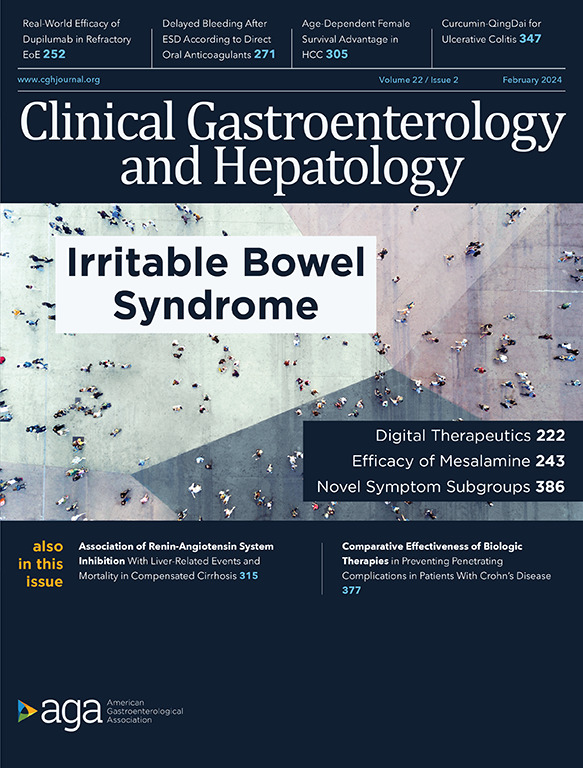与测压法相比,翻转平移术中的内窥镜镇静类型对翻转运动分类没有明显影响。
IF 12
1区 医学
Q1 GASTROENTEROLOGY & HEPATOLOGY
引用次数: 0
摘要
背景与目的:功能性管腔成像探针(FLIP)测压术可在内镜镇静时评估食管运动,通常与清醒患者进行的高分辨率测压术(HRM)并行。本研究旨在评估内镜镇静对 FLIP 食管运动评估的影响:这项回顾性研究纳入了在镇静内镜检查期间完成 FLIP 测压,且 HRM 诊断为芝加哥分类 v4.0 的成人患者。根据 FLIP 过程中使用的镇静类型,即使用咪达唑仑和芬太尼的意识镇静(CS)或使用异丙酚的监测麻醉护理(MAC),对 HRM 诊断与 FLIP Panometry 运动分类进行比较:454名患者(平均(标清)年龄53(17)岁,62%为女性)在CS(174人,占38%)或MAC(280人,占62%;177/280人的MAC包括芬太尼)下完成了FLIP泛影测量。对比 CS 与 MAC,FLIP Panometry 运动分类中的 HRM 诊断并无差异(所有 5 个 FLIP Panometry 分类中的 P=0.306;特定 FLIP 分类中的 P 值为 0.202-0.856)。在使用 CS 完成的 FLIP 与使用芬太尼的 MAC(P=0.098)或不使用芬太尼的 MAC(P=0.0261)之间,每个 FLIP Panometry 分类中的 HRM 诊断比例也没有差异:在 FLIP 过程中使用 CS 或 MAC 作为镇静剂对 FLIP Panometry 诊断与 HRM 之间的关系没有临床意义上的影响。这支持了在镇静内镜检查中使用 FLIP Panometry 诊断食管运动障碍的有效性。本文章由计算机程序翻译,如有差异,请以英文原文为准。

Endoscopic Sedation Type During FLIP Panometry Does Not Significantly Impact FLIP Motility Classification Relative to Manometry
Background & Aims
Functional lumen imaging probe (FLIP) panometry evaluates esophageal motility at the time of sedated endoscopy and often parallels high-resolution manometry (HRM) performed in awake patients. This study aimed to assess the impact of endoscopic sedation on FLIP evaluation of esophageal motility.
Methods
Adult patients who completed FLIP panometry during sedated endoscopy and had a conclusive Chicago Classification version 4.0 diagnosis on HRM were included in this retrospective study. HRM diagnoses relative to FLIP panometry motility classifications were compared by sedation type used during FLIP (ie, conscious sedation [CS] with midazolam and fentanyl or monitored anesthesia care [MAC] with propofol).
Results
A total of 454 patients (mean [standard deviation] age 53 [17] years; 62% female) completed FLIP panometry under CS (n = 174; 38%) or MAC (n = 280; 62%; 177/280 MAC included fentanyl). On comparison of CS versus MAC, HRM diagnoses within FLIP panometry motility classifications did not differ (P = .306 across all 5 FLIP panometry classifications; P values .202–.856 within specific FLIP classifications). The proportion of HRM diagnoses within each FLIP panometry classification also did not differ between FLIP completed with CS versus MAC with fentanyl (P = .098) or MAC without fentanyl (P = .0261).
Conclusions
Whether CS or MAC was used as sedation during FLIP did not have a clinically significant impact on the relationship between diagnosis on FLIP panometry and HRM. This supports the validity of diagnosing esophageal motility disorders using FLIP panometry during sedated endoscopy.
求助全文
通过发布文献求助,成功后即可免费获取论文全文。
去求助
来源期刊
CiteScore
16.90
自引率
4.80%
发文量
903
审稿时长
22 days
期刊介绍:
Clinical Gastroenterology and Hepatology (CGH) is dedicated to offering readers a comprehensive exploration of themes in clinical gastroenterology and hepatology. Encompassing diagnostic, endoscopic, interventional, and therapeutic advances, the journal covers areas such as cancer, inflammatory diseases, functional gastrointestinal disorders, nutrition, absorption, and secretion.
As a peer-reviewed publication, CGH features original articles and scholarly reviews, ensuring immediate relevance to the practice of gastroenterology and hepatology. Beyond peer-reviewed content, the journal includes invited key reviews and articles on endoscopy/practice-based technology, health-care policy, and practice management. Multimedia elements, including images, video abstracts, and podcasts, enhance the reader's experience. CGH remains actively engaged with its audience through updates and commentary shared via platforms such as Facebook and Twitter.

 求助内容:
求助内容: 应助结果提醒方式:
应助结果提醒方式:


